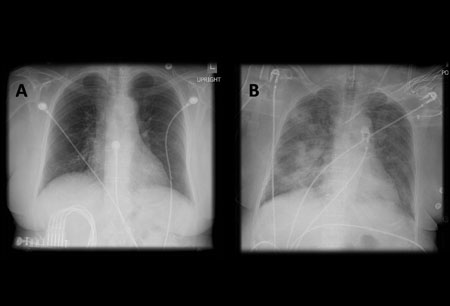Resumen
Definición
Anamnesis y examen
Principales factores de diagnóstico
- presencia de factores de riesgo
- tos aguda o crónica
- fiebre
- disnea
- sibilancia
- crepitaciones
Otros factores de diagnóstico
- Laringoespasmo
Factores de riesgo
- disminución del nivel de consciencia (puntuación <9 en la Escala de Coma de Glasgow)
- mayor gravedad de la enfermedad
- anestesia general
- edad >70 años
- sexo masculino
- traumatismo de cráneo
- enfermedad cerebrovascular
- tubo endotraqueal o cánula de traqueotomía
- disfagia
- complicaciones en las vías respiratorias
- papilla de bario
- enfermedad por reflujo gastroesofágico
- sondas de alimentación
- posición en decúbito supino
- vaciamiento gástrico retrasado
- obesidad
- fármacos que reducen el tono del esfínter esofágico
Pruebas diagnósticas
Primeras pruebas diagnósticas para solicitar
- radiografía de tórax
Pruebas diagnósticas que deben considerarse
- tomografía computarizada (TC) de tórax
- broncoscopia con lavado broncoalveolar
- hemograma completo (HC)
- gasometría arterial
- hemocultivo
- Toracocentesis
Algoritmo de tratamiento
neumonitis por aspiración de contenido gástrico
neumonitis por aspiración de bario
Colaboradores
Autores
Augustine Lee, MD
Professor of Medicine
Division of Pulmonary and Critical Care Medicine
Mayo Clinic Florida
Jacksonville
FL
Divulgaciones
AL declares that he has no competing interests.
Spencer Deleveaux, MBBS
Fellow
Division of Pulmonary and Critical Care Medicine
Mayo Clinic Florida
Jacksonville
FL
Divulgaciones
SD declares that he has no competing interests.
Agradecimientos
Dr Augustine Lee and Dr Spencer Deleveaux would like to gratefully acknowledge Dr Madison Macht, Dr Kamran Mahmood, Dr Scott Shofer, Dr Septimiu Murgu, and Dr Henri Colt, previous contributors to this topic.
Divulgaciones
MM, KM, SS, SM, and HC declare they have no competing interests.
Revisores por pares
Andrew Parfitt, MBBS, FFAEM
Clinical Director
Acute Medicine
Associate Medical Director
Consultant Emergency Medicine
Guy's and St Thomas' NHS Foundation Trust
Clinical Lead and Consultant
Accident and Emergency Medicine
St Thomas' Hospital
London
UK
Divulgaciones
AP declares that he has no competing interests.
Momen M. Wahidi, MD, MBA
Director
Interventional Pulmonology
Division of Pulmonary, Allergy, and Critical Care Medicine
Assistant Professor of Medicine
Duke University Medical Center
Durham
NC
Divulgaciones
MMW declares that he has no competing interests.
Agradecimiento de los revisores por pares
Los temas de BMJ Best Practice se actualizan de forma continua de acuerdo con los desarrollos en la evidencia y en las guías. Los revisores por pares listados aquí han revisado el contenido al menos una vez durante la historia del tema.
Divulgaciones
Las afiliaciones y divulgaciones de los revisores por pares se refieren al momento de la revisión.
Referencias
Artículos principales
Marik PE. Aspiration pneumonitis and aspiration pneumonia. N Engl J Med. 2001 Mar 1;344(9):665-71. Resumen
Smith Hammond CA, Goldstein LB. Cough and aspiration of food and liquids due to oral-pharyngeal dysphagia: ACCP evidence-based clinical practice guidelines. Chest. 2006 Jan;129(1 suppl):154S-68S.Texto completo Resumen
American Society of Anesthesiologists. Practice guidelines for preoperative fasting and the use of pharmacologic agents to reduce the risk of pulmonary aspiration: application to healthy patients undergoing elective procedures - an updated report by the American Society of Anesthesiologists task force on preoperative fasting and the use of pharmacologic agents to reduce the risk of pulmonary aspiration. Anesthesiology. 2017 Mar;126(3):376-93.Texto completo Resumen
Smith I, Kranke P, Murat I, et al. Perioperative fasting in adults and children: guidelines from the European Society of Anaesthesiology. Eur J Anaesthesiol. 2011 Aug;28(8):556-69.Texto completo Resumen
Artículos de referencia
Una lista completa de las fuentes a las que se hace referencia en este tema está disponible para los usuarios con acceso a todo BMJ Best Practice.

Diferenciales
- Síndrome de dificultad respiratoria aguda
- Exacerbación asmática
- Fibrosis quística con exacerbación
Más DiferencialesGuías de práctica clínica
- ACR appropriateness criteria: dysphagia
Más Guías de práctica clínicaInicie sesión o suscríbase para acceder a todo el BMJ Best Practice
El uso de este contenido está sujeto a nuestra cláusula de exención de responsabilidad